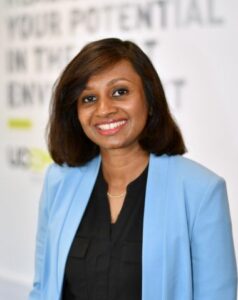“Digital accessibility is about inclusion, equity, and making sure no-one is left behind,” shared the University of Reading’s Digital Accessibility Officer, Tharindu Liyanagunawardena.
 Tharindu became the University of Reading’s first Digital Accessibility Officer in 2022, but this wasn’t always her destined career path. Initially, Tharindu came to Reading as an international student from Sri Lanka to undertake a PhD in computer science.
Tharindu became the University of Reading’s first Digital Accessibility Officer in 2022, but this wasn’t always her destined career path. Initially, Tharindu came to Reading as an international student from Sri Lanka to undertake a PhD in computer science.
She said: “I was inspired to study for a PhD in computer science, particularly focused on researching technology for distance education, or remote learning. At that time, e-learning was only just being introduced in Sri Lanka and I wanted to explore how technology could improve access to higher education.
“I’m proud to have completed my PhD within the minimum time of three years whilst raising my twin toddlers, which was not easy! After graduating I started work at the University of Reading as a postdoctoral researcher, then became a Teaching Fellow. I then left Reading to work as an Instructional Designer and Learning Technology Researcher, before returning to Reading to take up the role of Digital Accessibility Officer.
“My career journey from software engineer to lecturer, to researcher, to learning technologist, and now Digital Accessibility Officer, feels like it has come full circle.
“What once seemed like a series of unrelated shifts now reveals itself as a purposeful path, with each step building on the last in meaningful and unexpected ways.
“Digital accessibility is closely tied to how systems are designed so having a technical background can be a real advantage.”
An essential part of life
Most people are not fully aware of digital accessibility unless they, or someone close to them, has an accessibility need. “It can seem abstract, but for those who rely on assistive technologies, it’s a very real and essential part of daily life,” Tharindu shared.
It was during her time at Reading that Tharindu was exposed to the importance of digital accessibility when she was the co-creator and lead facilitator of the University of Reading’s first MOOC (Massive Open Online Course), called Begin Programming: Build Your First Mobile Game.
She said: “It was a popular course with over 55,000 participants in one run. I’ll always remember virtually meeting with one learner with colour blindness who had struggled with some of the colours we had used. Since the game was customisable, we were able to help them change the colours, but that experience highlighted the importance of accessibility.
“It inspired me to ensure that the content we create at the University is inclusive for everyone and that led me to where I am today.”
Tharindu explains that designing with digital accessibility in mind is critical to those with specific needs, but also improves the online experience for everyone.
She said: “Think of it this way: we wouldn’t accept a supermarket without ramp access, excluding wheelchair users from the physical space. So why should we accept a supermarket website that isn’t digitally accessible, preventing people who use screen readers or voice control from shopping online?
“Digital accessibility is about inclusion, equity, and making sure no-one is left behind. It’s even more important in the modern day as we rely on so many essential digital services: making appointments, online banking, booking tickets, buying groceries and more.”
Raising awareness
One of the most important parts of Tharindu’s role is raising awareness of digital accessibility. She said:
“Digital accessibility isn’t something one person can achieve alone – it requires a collective effort across the University.
“In my role I provide guidance on making content accessible and advise on accessibility during procurement to ensure any new systems we adopt meet accessibility standards. I work closely with the web team, contribute to required accessibility testing and legal statements, and collaborate with departments, schools, and professional services across the University. For example, I recently worked with the Alumni team to improve the colour choices in their e-newsletter, making it more accessible to all readers.”
Tharindu reflected on the work she has successfully undertaken to raise awareness of digital accessibility at the University.
She said: “I’m particularly proud to have launched the first ever campaign at the University of Reading focused on digital accessibility. It was called the Look Again campaign and was very successful. We have come a long way from people wondering what digital accessibility is, to now considering it when creating content.
“In my spare time I also volunteer as the co-chair of the Women@Reading plus allies diversity network with over 575 members. This year I was also really proud to receive the Equality, Diversity and Inclusion Volunteer of the Year Award in recognition of the work I do in this volunteer role.”
You can take a look at the University’s digital accessibility resources, or find out more about the Look Again campaign.
Top Tips
Tharindu shared her three top tips to keep in mind when designing online content to be digitally accessible.
She said: “Firstly, when you are creating content, use heading styles available in software packages such as Microsoft Office, instead of using big bold fonts for headings to enable screen-reading functionality.
“Secondly, don’t use colour as the only means of differentiating information – this will be inaccessible to people who may not perceive colour the same way as you. For example, 1 in 12 men and 1 in 200 women have red-green colour vision deficiency so it is much more common than people may think.
“And thirdly, instead of using here or click here for links, provide a meaningful link text which explains what the link will take the user to. For example you can find out more about our digital accessibility resources.”
Read how another Reading graduate is making accessibility more accessible and affordable for everyone.




